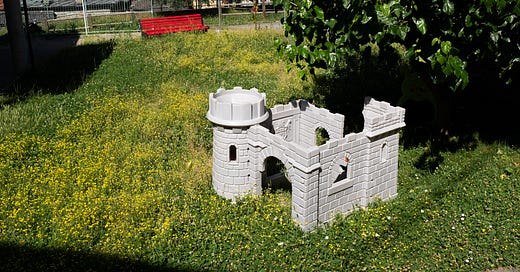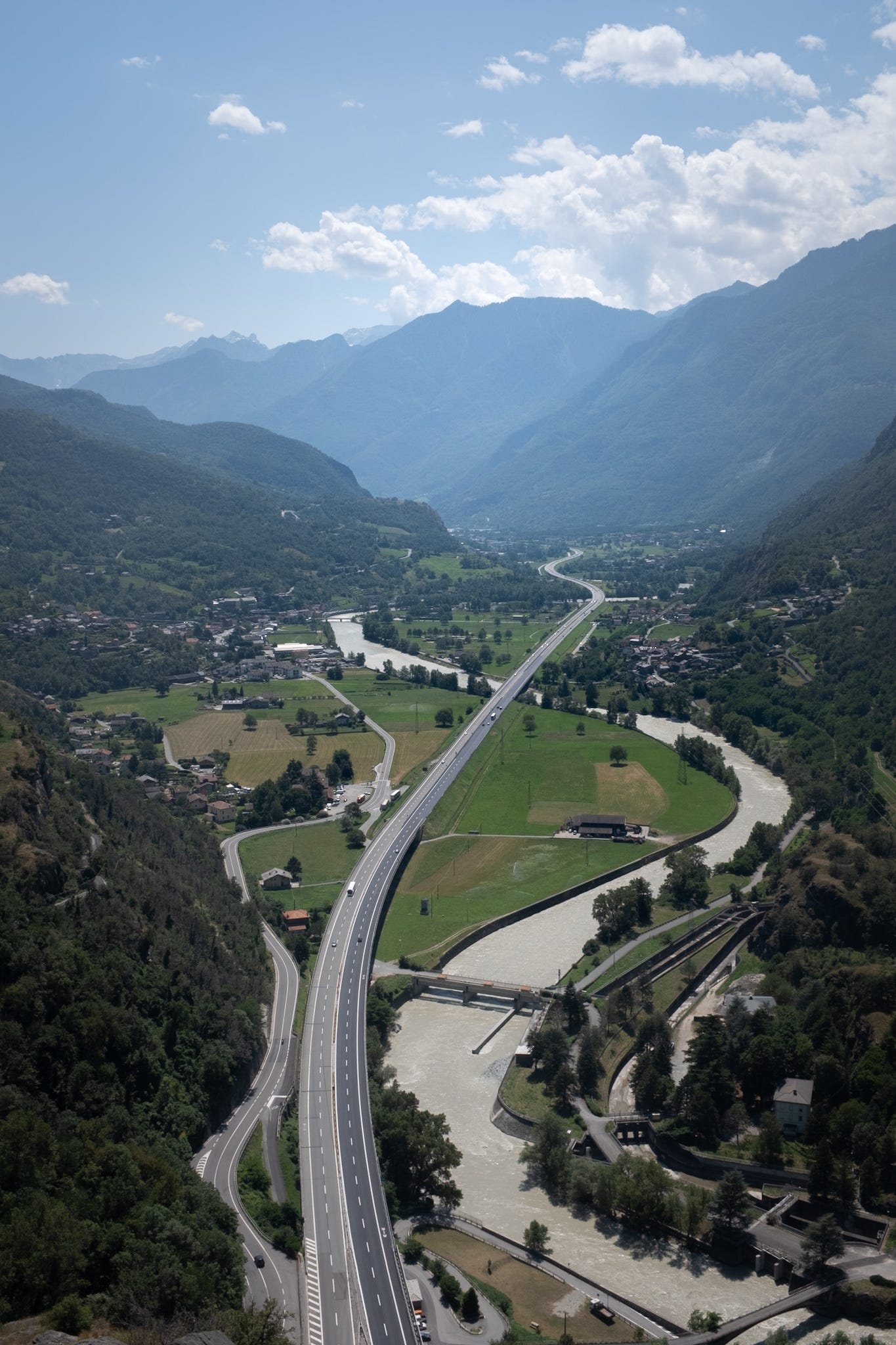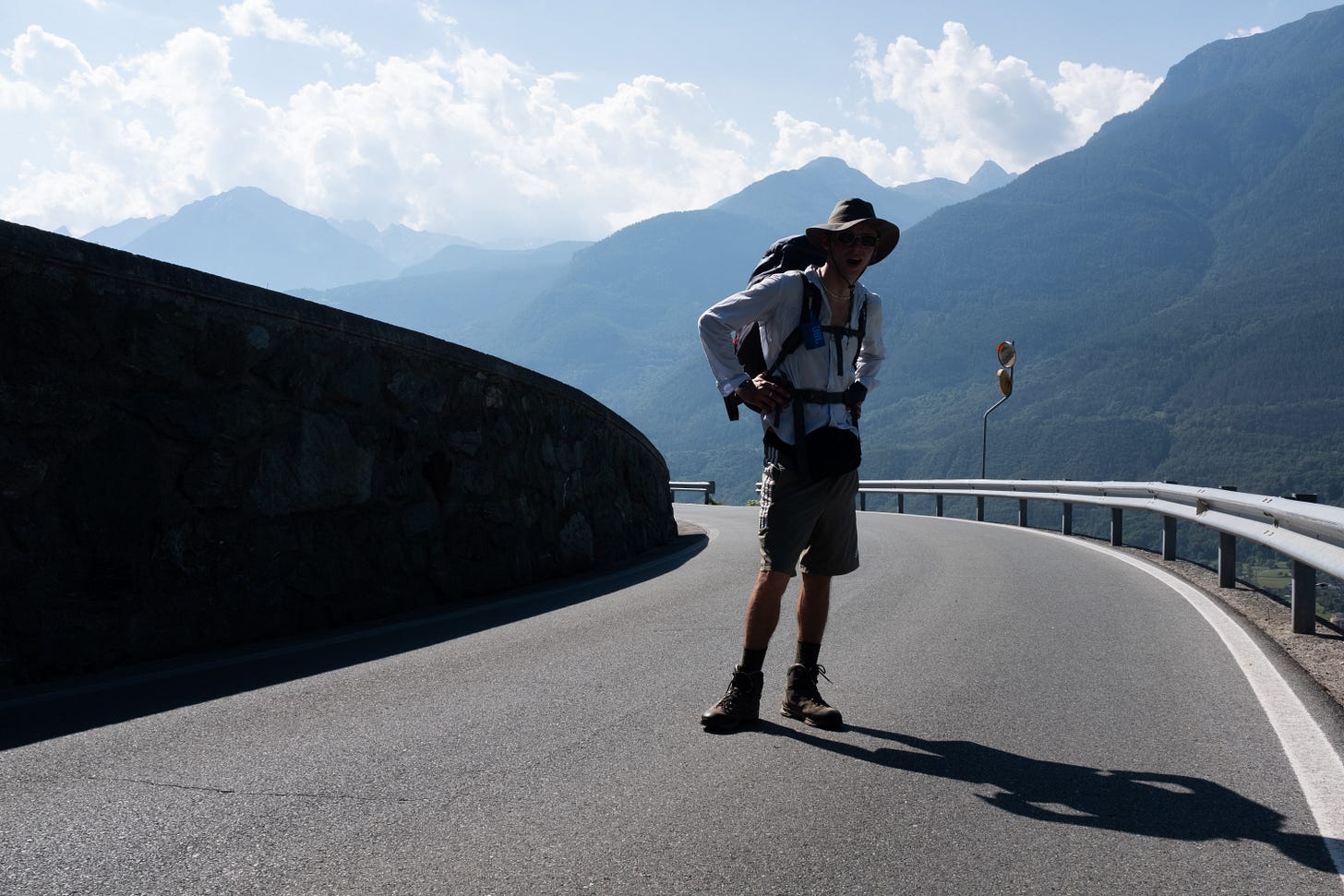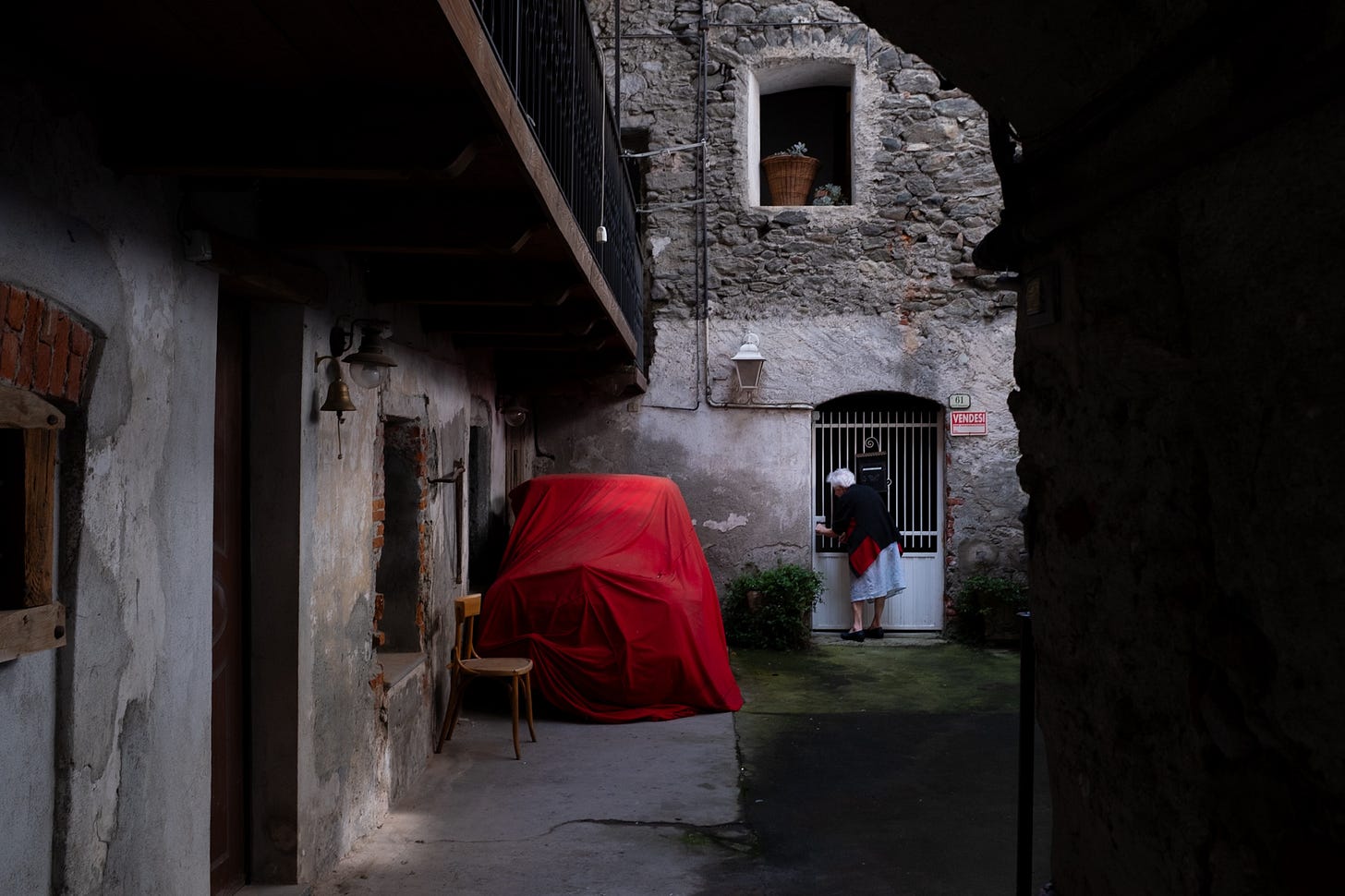I reached Aosta in the blue of evening. The bus station was smattered with a handful of pottering people and the town was quiet. The mountains looked like huge sleeping animals, glimpsed between grey angular facades and straight modern balconies.
My brother had reached the town earlier that day and I was joining him for a week of walking. He’d begun his pilgrimage two days before on the Great St Bernard Pass and I found him having a beer with a German called Lars. They were both Pellegrini, though Lars had begun deeper in Switzerland. They were both bound for Rome.
Thomas and I had a hotel on the edge of town, the other side of a frothing river with a view that swept up the valley down which we’d be walking. We got up early the next morning to avoid the heat. There was a long way to go.
Not much stirred as we hooked our thumbs into our bag straps and strode over the cobbles, our steps sprung with the thrill of a long journey just begun. We crossed the river, its froth now a shade of bronze in the low morning light. Beside it, the twisted pipes of a huge silent factory writhed motionless. Its windows were murky, its roof vast and horrifying.
We walked out of town, under the arch of Augustus. Ribbed in scaffold, it was built two thousand years ago next year, in celebration of the terminal subjugation of the Salassi tribe who used to call this valley home. Augustus crushed and slaughtered two thousand of them not far from here; the rest were sold to slavery. The town was named after him.
For centuries pilgrims on this path would have passed the arch. The Via Francigena ran to Canterbury behind us and almost equidistant to Rome ahead. Originally it was a path for trade, that linked Rome to the Francs the other side of the Alps. Its path in France cemented those of the Celtic Tin route and in Italy sections of the Logobard Routes which ran from Pavia to Rome, Benevento and the Sanctuary of San Michele del Gargano. After the Muslims conquered Jerusalem in 640 AD, Rome became the main pilgrimage site and this became the main route there from France and Britain.
For almost two millennia, the Via Francigena would have traced the frothing river through the flat glacial bottom of the Aosta Valley. From the town, it bobbles and chops its way east, then doglegs south at Châtillon where it snakes through the narrow gorge under the fortress at Bard, on to Ivrea. There the mountains fall away into nothing but flat and the river and the Via Francigena diverge at last. Today an Autostrada and railway occupy the valley floor and the path for pilgrims does its best to avoid them. Nicer walking but harder work.
We wove up through stone hamlets with crooked rooves and warped wooden fencing, then wove back down through modern suburbs with triangular rooves and bright plaster. Sometimes the path ran along or under the motorway, as it snaked its own riverlike run through the valley, before climbing steeply up a vast limestone lip once more into thickets of trees of paradise or rows of vines, huddling villages, fading wooden doors and tractors abandoned indefinitely.
It was good to be walking. Hitchhiking always requires plenty of it, but it’s not the kind that’s good for the soul, the kind that has kept pilgrims on the road for millennia. The rhythm of your steps jangles everything inside and sorts it all like a wheat thresher. Everything seems to fall into place. Things are so much clearer when you’re walking.
On a tarmac road through a grove of mountain ash, we passed an old lady pushing a pram. Chrysanthemums and geraniums gave sudden hot flashes to the blue of the hillsides and bubbling towers of cloud rose and fell over the distant peaks. She had a plume of white hair and sang gently to the child as she wandered. She stopped to smile as we passed. “Via Francigena?” She asked, “Roma?” Then she gave us a bouquet of best wishes and continued with her song.
We reached the next town, Châtillon that night exhausted by 20 miles of hills in the heat. It’s a rare fatigue after a day’s walking, especially the first day: feet hot with pain, legs siezed up, shoulders sharp and sore. Padre Stephano admitted us to the Convent Cappuccini from a small courtyard. He was a jolly man who peered up at us through blue glasses which had a string around his neck. His crucifix rested on his round belly. The little figure of Christ, reclining almost horizontal, gently wobbled when he laughed. Father Stephano shuffled us into the pilgrim room where three simple beds lay side by side. It was a low-ceilinged bare room with a door straight onto the courtyard by the church. Padre Stephano took a seat at the wooden desk and slid his glasses up his nose.
“Nicholas….Hug?” He asked, reading our passports, his accent thick Italian, “How do you say this? Hug?”
“Hugh,” I corrected.
“Hug?”
“Hew.”
He practised the motion with his mouth silently then, “Hyoooo!” The word shot out like a Formula One car. “Haaayooooo!”
Next to him was a map of western Europe with a red line from Canterbury to Rome. When he’d mastered my middle name, or got near enough, he asked us how far we were walking. Thomas said to Rome, tapping the map, 1000km away. “Where did you start?” Padre Stephano interegated.
“Great St Bernard Pass.”
“What!” Padre Stephano ejaculated, “Not Canterbury!”
Lars arrived later that evening. His knee had been giving him grief, an ominous sign given how far he had to go. Padre Stephano sent us to a trattoria in town with a special pilgrim code. We joked that he was on commission. The walls were painted lemon yellow and a family was celebrating three birthdays at once in the room next door.
Lars had done the Camino in Spain before, making him the most experienced Pellegrini among us. It’s the most popular pilgrimage in Europe and he said there were thousands of people on it at once. He’d walked three weeks of it. Until recently, he’d been working in climate change mitigation but it had got too stressful so he quit to walk to Rome. It would take him 2 months if all was well. He said he was going to get a bus across the Po Valley which, by all accounts, was 10 days of rice fields, heat and mosquitos.
We drank several carafes of local wine and staggered, as much from stiffness as wine, back to the convent where our hand-washed socks were hanging on the line. Then the next morning we rose early and walked on.







